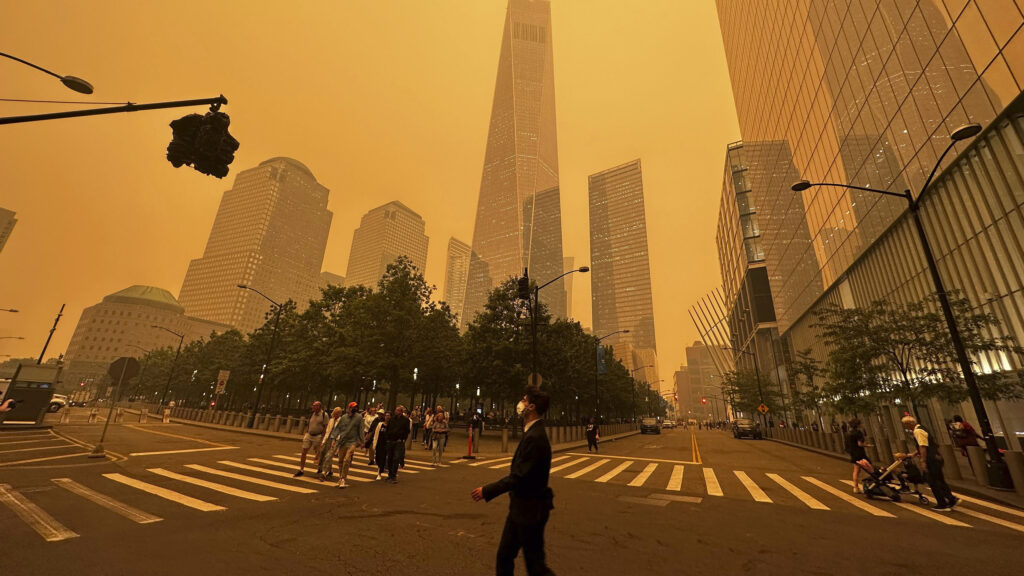An unusually early and ferocious outbreak of forest fires across Canada has sent unprecedented amounts of smoke pollution to regions of the eastern United States unaccustomed to such hazards. Three years after the onset of the Covid-19 pandemic, the ensuing air pollution has once again put respiratory health at the forefront of many North Americans’ minds.
The primary health concern from wildfire smoke comes from the amount of very fine particulates in the air, smaller than 2.5 microns in diameter. The measure of this is commonly abbreviated as PM2.5.
Many of the strategies for protection against these motes turn out to be similar to the strategies people around the world implemented to protect themselves from viral particles during the height of Covid-19. Respirators and air cleaners, for example, offer significant protection against the onslaught of smoke particulates.
Here are just a few ways in which the public health lessons of Covid may now help people to minimize health risks from air pollution.
Masks and respirators
What’s the same: Amid the pandemic, many people became familiar with respirator standards such as N95 and KN95. High-quality and well-fitting respirators can also be extremely effective at filtering PM 2.5 pollution.
As a refresher, N95 is the U.S. standard defined by the National Institute for Occupational Safety and Health and is effective at filtering 95% of particulate matter from the air including most particulates in the PM2.5 category. KN95, the Chinese standard, has equivalent air filtering performance to N95 respirators, but also has less stringent parameters for mask design. Many KN95 respirators lack gaskets around the nose or use ear loops instead of head straps, both of which often result in a poorer fit.
Both N95 and KN95 masks offer a high degree of protection from wildfire smoke, but it is important that the respirator fits snugly against the face. For KN95 respirators, it is especially important to ensure the fit is snug and that there aren’t leaks around the edges.
What’s different: The largest difference when it comes to masks as a form of protection is that, in order to prevent disease transmission, masks must work on air being exhaled as well as inhaled. But in the context of air pollution like wildfire smoke, the most important goal is to filter the air being inhaled.
During Covid, public-health experts encouraged people to mask up in order to protect other people as well as themselves. That meant loose-fitting cloth masks and paper surgical masks, while far less effective than N95s at filtering air, were still offered as a moderately effective option for stopping viral particles that are exhaled.
Meanwhile, experts have advised against the use of things like P100 respirators commonly sold at hardware stores and used around hazardous materials, since they usually feature a valve that allows for breath to be expelled unfiltered.
The reverse is true when dealing with air pollution from wildfire smoke. Cloth and paper masks offer very weak protection against the inhalation of fine particulate matter because they don’t fit snugly against the face. By contrast, high-quality P100 respirators offer even more protection than N95 respirators, and the valve design is not problematic in this case.
Air cleaners
What’s the same: For indoor settings, the same kinds of air cleaning and filtering techniques and devices that are effective against viral particles are also effective against wildfire smoke particulates.
In places with central air conditioning, use of a high efficiency filter with a MERV rating of 13 or greater can filter a significant amount of fine particle pollution from the air.
Dedicated HEPA filtration devices are also highly effective at cleaning the air in smaller enclosed spaces. But many devices are only designed to clean the air in a single room, not the entire home. They also need to be run at high-speed settings to be effective at fully cycling the air in a room.
Another option for air cleaning that rose in popularity during the pandemic is what’s known as a Corsi-Rosenthal box or cube. This is a simple, DIY contraption consisting of four MERV 13 or greater furnace filters taped to an inexpensive box fan. It offers air cleaning performance similar to dedicated HEPA air filters.
Ventilation
What’s different: Ventilation of indoor spaces is quite important to prevent the build-up of airborne viral particles. Obviously, when dealing with wildfire smoke, the goal is very different: to stop polluted air from getting indoors.
Experts advise keeping windows closed, closing any fresh-air intakes on air conditioners, including in cars, and considering identifying a “clean room” in the home that has as little exposure to outside air as possible.


